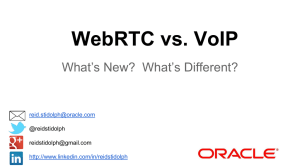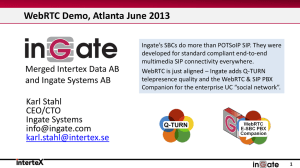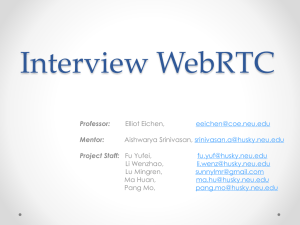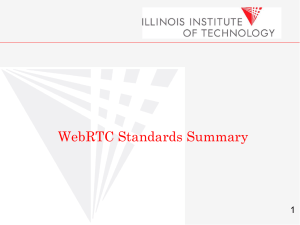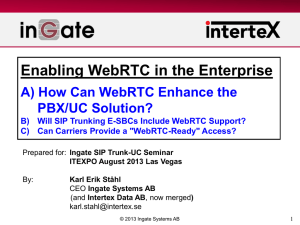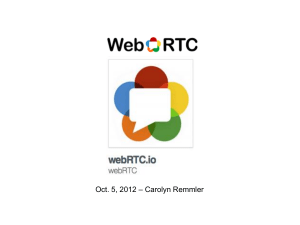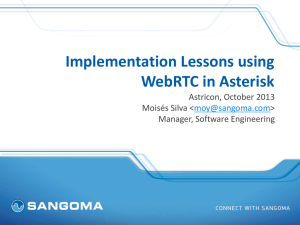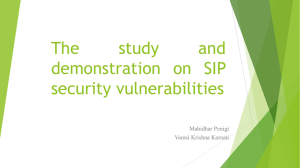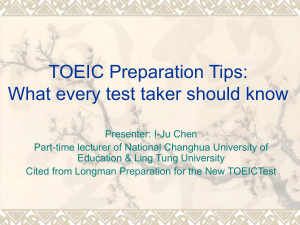WebRTC
advertisement
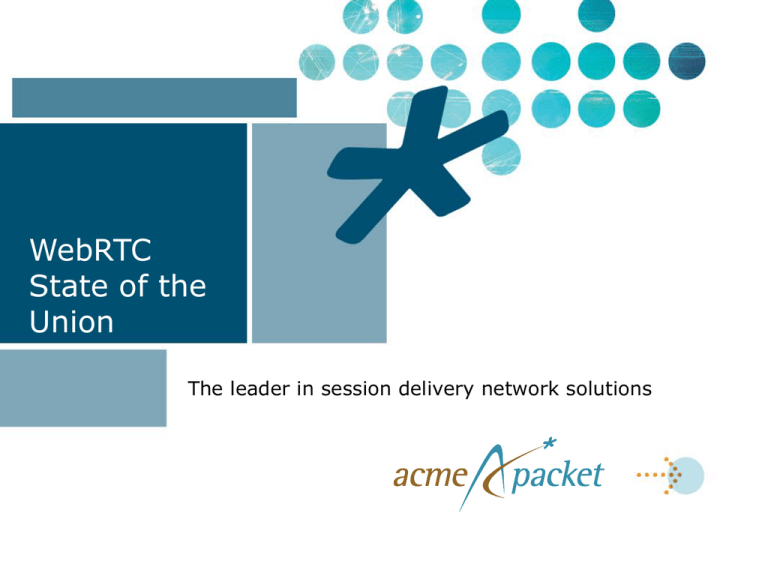
WebRTC State of the Union The leader in session delivery network solutions Acme Packet session delivery networks for trusted, first class services & applications Applications Over-the-top Services Session delivery network (SDN) Session Intelligence Interoperability Quality Session Controls Reliability Security IP transport network 2 Proven widespread interoperability Services & applications Call control & media gateways Firewall/NATs Endpoints (IP phones, IADs, MTAs, IP PBX, etc. ) 3 What is WebRTC? (and why you should care) What is WebRTC (Real Time Communications)? Emerging method of web-based RTC Another type of access framework Why the hype? Web: most dynamic, innovative place on planet RTC has largely been absent WebRTC delivers RTC to those that create the Web Why should you care? WebRTC will be an important access method in the future for SPs, contact centers, and enterprises 4 Level set What is The Web? A distributed system overlaid on The Internet Made up of interlinked text, images, videos, and other multimedia “hyper”media Over 640,000,000 websites on The Internet Who makes the Web? Web developers: the largest dev. community on Earth What makes up the Web? Made up of servers, databases, and browsers Loosely linked using protocols and techniques HTTP, PHP, JavaScript, MySQL, HTML5, CSS, Python, REST…and more! The Web is very different from traditional communications networks such as IMS, UC, the PSTN 5 WebRTC The World Wide Web gets eyes and ears Real Time voice and video woven into The Web Acme Packet SDN enables Enterprises, Service Providers, and OTTs to join the revolution 6 What is WebRTC? Is it WebRTC or RTCWeb? Both! (kind of) WebRTC is the name for W3C Standard efforts RTCWeb is the name for IETF Standard efforts What is the purpose? To enable Real Time Communications (RTC) in The Web environment What is all the hype about? Web environments are the most dynamic and innovative places in technology…but RTC has largely been absent WebRTC delivers the power of RTC directly into the hands of The Web 7 WebRTC (technically speaking) A powerful set of audio/video communications tools Best of breed echo canceler Audio/video codecs Video jitter buffer, image enhancer SRTP stack Peer-2-peer tools for NAT STUN, TURN, ICE …all built into your web browser! These tools are utilized by Web developers Accessed via JavaScript 8 The media engine of WebRTC Still being finalized VP8 vs. H.264 highly debated G.711 and Opus are mandatory voice codecs Video codecs not yet set SRTP and STUN/ICE/TURN Required Voice Codecs Transport G.711 Opus DTLS-SRTP SDES-SRTP STUN ICE TURN Multiplexing Video Codecs VP8 H.264 9 The signaling of WebRTC Traditional Role of Signaling is the information concerning the namespace, establishment, control, and billing of a communication session. WebRTC has no traditional signaling channel! It relies on a Web, or Traditional Signaling Channel ? Calling Identity Called Identity Session Description Billing Info ? Calling Identity Called Identity Session Description Billing Info “…Hi Bob, this is Alice…” 10 Beep Beep Signaling Signaling Media Media The Great Divide 11 Session delivery challenges WebRTC NOT Exempt • Security • Authentication and authorization • Confidentiality • DoS and overload protection • Identity management • Service reach • Interoperability and interworking • IPv4 <-> IPv6 • Firewalls • Service assurance • QoS • Reliability • Regulatory compliance • Lawful intercept • Call recording 12 Security All the challenges/vulnerabilities of Web-based applications Remote code execution Format string vulnerabilities XSS (Cross Site Scripting) Username enumeration PLUS Real time communications Toll fraud/theft of service Eavesdropping Session overloads (SPIT) SPAM over Internet Telephony Session hijacking 13 Regulatory compliance • Adding WebRTC to SDN means NO compromise on compliance for applications that require it • • • • Web-to-Call Center Web-to-Emergency Svc. Web-to-Financial Institute Web-to-Service Provider Call Center UC Banking IMS Hosted UC Emergency SVC • Lawful intercept • Call recording 14 WebRTC Use Cases SP subscriber access via WebRTC methods Browser-based RTC to complement SIP offerings Enterprise UC without thick or thin client soft phones Easier to maintain & break single UC vendor lock Contact centers embedding RTC into customer service web pages SIP WebRTC Customer satisfaction & lower costs 15 WebRTC vs. SIP: Bridging a Great Technology Divide SIP-over-WebSockets REST call control SRTP en-/de-crypt Media Transcoding ICE/STUN /TURN IWF 16 WebRTC: New Access Framework, Same Session Delivery Challenges • Service reach • Interoperability and interworking • Firewall/NAT traversal • Peer-to-peer vs. core transit Service provider, enterprise & contact center • Security • Authentication & authorization • Confidentiality • DoS and overload protection • Identity management • Service assurance • Availability & reliability • QoS, QoE • Regulatory compliance • Call recording • Lawful intercept SIP WebRTC 17 Addressing BYOD & enterprise mobility challenges UC devices today use SIP or proprietary methods WebRTC1 & HTML5 will play a role in BYOD/BYOA But, new access methods must coexist with SIPbased UC infrastructure & device… …and Acme Packet helps coexistence UC devices today: SIP, SCCP, H.323, UNIStim, etc. Emerging devices & apps of tomorrow Note 1: WebRTC is used here in a generic context to refer to any type of browser- or web-based real-time collaboration (RTC) app. The term “WebRTC” is a specific term used to describe an approach driven by Google but there are many other comparable app or browser driven RTC approaches 18 Enterprise UC & CC Use Cases How WebRTC helps contact centers WebRTC embeds RTC capabilities directly into web pages No more click-to-call or call back required Uses the browser’s media capabilities to directly establish customer-agent session (over-the-top, not via PSTN) Browser context (page view) info can be shared with agent Voice / video / browser view context shared between customer & agent CRM Customer WebRTC-enabled website page ACD/ PBX Agent 20 How WebRTC helps enterprise UC Provides UC on any device with a WebRTC-compatible browser Allows for browser-based UC independent of UC client vendor Doesn’t require a thick UC client to be installed & maintained RTC apps on employee devices Enterprise UC System Seamless & secure remote worker access via secure WebRTC methods Has potential to be compatible with existing enterprise UC system 21 WebRTC + multi-vendor UC WebRTC endpoints must seamlessly interconnect to existing UC clients & servers WebRTC Session Director ensures interop between WebRTC signaling & media and existing enterprise UC systems WebRTC signaling methods (i.e. SIP over WebSockets or REST WebRTC Endpoint (third-party UC app) Existing Enterprise UC signaling methods (i.e. SIP) SIP-associated media methods (i.e. RTP) WebRTC-associated media methods (i.e. SRTP & STUN, TURN, ICE) Acme Packet Application Session Director Enterprise UC System • Strong Security • Flexible Interoperability • High Availability 22 Enterprise mobility example WebRTC enables a new class of devices & applications that can be use for enterprise mobility WebRTC Session Director enables WebRTC apps to act as an extension to existing UC system desk phones Enterprise UC System SIP Existing Deskphone SIP Trunk UC client app (connected via WebRTC) WebRTC Employee Tablet PSTN Acme Packet Application Session Director 23 Acme Packet/Plivo Demos Dallas, DC, San Jose, Amsterdam, Singapore Your Carrier of Origination, DIDs, Termination Choice SIP SIP SIP SIP TDM to SIP via gateway or direct via SIP Plivo Demos The following demos must be launched with Google Chrome: Plivo Conference bridge Go to nacr.plivo.com Follow directions on screen Contact Mike Lauricello for the Softphone Call Center demo: Mike Lauricella, BD at Plivo Inc cell: 415.857.2518 mdl@plivo.com 27 WebRTC Summary Summary WebRTC will revolutionize real-time communications WebRTC is a new access framework (and poses the typical security & interop challenges) Acme Packet’s Application Session Controller unifies emerging web-based RTC with SIP-based RTC Questions & Thank you
